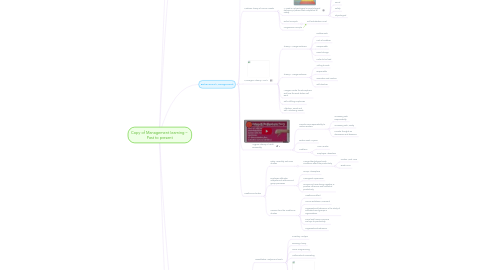
1. Scientific Management (Frederick Taylor)
1.1. Scientific Management emphasizes careful selection and training of workers and supervisory support.
1.2. Motion Study
1.3. Principles
1.3.1. Rules of Motion
1.3.2. Standardized Work Tools
1.3.3. Proper Working Conditions
1.3.4. Select Workers Carefully: Required Skills
1.3.5. Support workers by planning their goals and remove obstacles from their way
1.3.6. Train workers carefully: Support the workers and provide incentives to follow the 'science' of the job
1.4. Secure Maximum Prosperity
2. Classical Approaches
2.1. Administrative Principles (Henri Favol)
2.1.1. Rules of Management
2.1.1.1. Foresight
2.1.1.2. Organization
2.1.1.3. Coordination
2.1.1.4. Control
2.1.1.5. Command
2.1.2. Key Principles of Management
2.1.2.1. Scalar Chain
2.1.2.2. Unity of Command
2.1.2.3. Unity of Direction
2.1.2.4. Esprit de corps
2.1.2.5. Initiative
2.1.2.6. Personnel tenure
2.1.2.7. Equity
2.1.2.8. Order
2.1.2.9. Centralization
2.1.2.10. Remuneration
2.1.2.11. Subordination of individual interests
2.1.2.12. Discipline
2.1.2.13. Authority
2.1.2.14. Division of labour
2.2. Bureaucratic Organization (Max Weber)
2.2.1. Bureaucratic Organizations: Characteristics
2.2.1.1. Clear Division of Labour
2.2.1.2. Clear Hierarchy of Authority
2.2.1.3. Formal Rules and Procedures
2.2.1.4. Impersonality
2.2.1.5. Careers Based on Merit
2.2.2. A Bureaucracy is a rational and efficient form of organization founded on logic, order and legitimate authority.
2.2.3. Bureaucratic Organizations: Possible Disadvantages
2.2.3.1. Excessive paperwork or “red tape
2.2.3.2. Slowness in handling problems
2.2.3.3. Lack of Interest from Employee
3. Behavioural Management
3.1. Organizations And Communities (Mary Parker Follett)
3.1.1. Communities
3.1.2. Organization cooperate with one another and achieve an integration of interests
3.1.3. Collective Responsibility
3.1.3.1. Employee Ownership
3.1.3.2. Profit Sharing
3.1.3.3. Gain Sharing Plans
3.1.4. Profits are relative to the public
3.1.4.1. Managerial Ethics
3.1.4.2. Social Responsibility
3.2. Maslow’s Theory of Human Needs
3.2.1. A need is a physiological or psychological deficiency a person feels compelled to satisfy
3.2.1.1. Self-actualization
3.2.1.2. Self-esteem
3.2.1.3. Social
3.2.1.4. Safety
3.2.1.5. Physiological
3.2.2. Deficit Principle
3.2.2.1. Self-actualization Level
3.2.3. Progression Principle
3.3. McGregor’s Theory X and Y
3.3.1. Theory X Manger Believes
3.3.1.1. Dislikes work
3.3.1.2. Lack of ambition
3.3.1.3. Irresponsible
3.3.1.4. Resist change
3.3.1.5. Prefer to be fired
3.3.2. Theory Y Manger Believes
3.3.2.1. Willing to work
3.3.2.2. Responsible
3.3.2.3. Innovative and creative
3.3.2.4. Self-direction
3.3.3. Mangers create the atmosphere, and how the work station will work.
3.3.4. Self-Fulfilling Prophecies
3.3.5. Attention: Social and Self-Actualizing Needs
3.4. Argyris’s Theory of Adult Personality
3.4.1. Provide more responsibility to mature workers
3.4.1.1. Increasing Task Responsibility
3.4.1.2. Increasing Task Vareity
3.4.1.3. Provide thoughts on discussions and decisions
3.4.2. Define Goals Anyone
3.4.3. Problems
3.4.3.1. Low Morales
3.4.3.2. Employee Absentees
3.5. Hawthorne Studies
3.5.1. Relay Assembly Test-room Studies
3.5.1.1. Manipulated physical work conditions affect the productivity
3.5.1.1.1. Certain Work Time
3.5.1.1.2. Break Time
3.5.2. Employee attitudes, interpersonal relations and group processes
3.5.2.1. Group Atmosphere
3.5.2.2. Managerial Supervision
3.5.2.3. Groups can have strong negative or positive influences and individual productivity
3.5.3. Lessons from the Hawthorne Studies
3.5.3.1. Hawthorne Effect
3.5.3.2. Human Relations Movement
3.5.3.3. Organizational behaviour is the study of individuals and groups in organizations.
3.5.3.4. Social and human concerns are keys to producitvity
3.5.3.5. Organizational Behaviour
4. Modern Management Foundations
4.1. Quantitative Analysis and Tools
4.1.1. Inventory Analysis
4.1.2. Queuing Theory
4.1.3. Linear Programming
4.1.4. Mathematical Forecasting
4.1.5. Network Model
4.1.6. Management Science and Operation Research
4.2. Organizations as Systems
4.2.1. System
4.2.2. Subsystem
4.2.3. Open systems
4.2.4. High productivity when all the systems work together
4.3. Contingency Thinking
4.3.1. Contingency perspective tries to help managers understand situational differences and respond to them in ways appropriate to their unique characteristics.
4.3.2. Contingency Thinking tries to match management practices with situational demands.
4.4. Quality Management
4.4.1. Total Quality Management
4.4.2. Continuous Improvement.
4.4.3. ISO Certification
4.4.4. New ways to improve on quaility
4.5. Knowledge Management and Organizational Learning
4.5.1. Technology Driven Life
4.5.2. Knowledge Management
4.5.2.1. Property Rights
4.5.2.2. Trademarks
4.5.2.3. Patents
4.5.3. A learning organization continuously changes and improves, using the lessons of experience.
4.5.3.1. Mental models
4.5.3.2. Personal mastery
4.5.3.3. Systems thinking
4.5.3.4. Shared vision
4.5.3.5. Team learning
4.6. Evidence-Based Management
4.6.1. Decisions based on hard facets
4.6.2. High-performance organization = High-Quality Work Environment
4.6.3. High-performance organizations
4.6.3.1. People Oriented
4.6.3.2. Team Oriented
4.6.3.3. Information Oriented
4.6.3.4. Achievement Oriented
4.6.3.5. Learning Oriented
4.6.4. Scientific Method (Basic)
4.6.4.1. Research Question
4.6.4.2. Possible Expectations
4.6.4.3. Research Method
4.6.4.4. Data
4.6.4.5. Hypothesis: Accepted/Rejected
4.6.5. Staying Up-to-Date
4.7. 21st Century Leadership
4.7.1. Learning is key role 21st Century Leadership
4.7.2. Attributes
4.7.2.1. Inspiring Leader
4.7.2.2. Master of Technology
4.7.2.3. Global Strategist
4.7.2.4. Model of Ethical Behaviour
4.7.3. The Age of Information
4.7.4. Success: Willing To Learn
4.7.5. Requires
4.7.5.1. Work-Life Balance
4.7.5.2. Skillful
4.7.5.3. Learning

